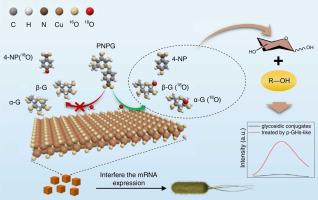Applied Catalysis B: Environment and Energy ( IF 20.2 ) Pub Date : 2023-03-15 , DOI: 10.1016/j.apcatb.2023.122639 Zhixuan Yu , Jinxing Chen , Daiyong Chao , Xiaoxuan Sun , Ling Liu , Shaojun Dong

|
Conversing proteinaceous enzyme behavior into nanomaterials is intriguing academically, but the threshold from mimicry to accessing sophisticated biological entities has not yet been crossed. Herein, we disclosed the pan-glycoside hydrolases-like (p-GHs-like) activities of Cu3P and Cu2O nanoparticles and decently confirmed their consistent catalytic mechanism as natural glycoside hydrolase, that is, the precise bond breaking, anomeric carbon configuration and catalytic attack mode. We then introduced p-GHs-like NPs into Escherichia coli to establish a feedback regulatory model for the β-D-glucuronidase (expressed by uidA) that was initially expressed in trace amounts. An upregulation of uidA from 72 to 1000 counts was induced by the p-GHs-like activities via pre-released β-glucuronides derivatives, further contributing to 1–2 orders enhancement of the enzyme production. We unearthed the specific catalytic mechanism to unlock a black box of enzyme-like inorganic feedback on the natural enzyme synthesis process, pushing mimicry leaped to physiological behavior.
中文翻译:

铜复合纳米粒子水解酶机理研究及其在水环境肠道细菌评价中的应用
将蛋白质酶行为转化为纳米材料在学术上很有趣,但尚未跨越从模仿到获取复杂生物实体的门槛。在此,我们公开了 Cu 3 P 和 Cu 2 O 纳米粒子的类泛糖苷水解酶 (p-GHs-like) 活性,并恰当地证实了它们与天然糖苷水解酶一致的催化机制,即精确的键断裂、异头碳配置和催化攻击模式。然后,我们将 p-GHs 样 NPs 引入大肠杆菌中,以建立 β- D 的反馈调节模型。- 最初以微量表达的葡萄糖醛酸酶(由 uidA 表达)。p-GHs 样活性通过预释放的 β-葡糖苷酸衍生物诱导 uidA 从 72 计数上调到 1000 计数,进一步促进酶产量提高 1-2 个数量级。我们发掘了特定的催化机制,打开了天然酶合成过程中类酶无机反馈的黑匣子,推动拟态跃升为生理行为。





















































 京公网安备 11010802027423号
京公网安备 11010802027423号